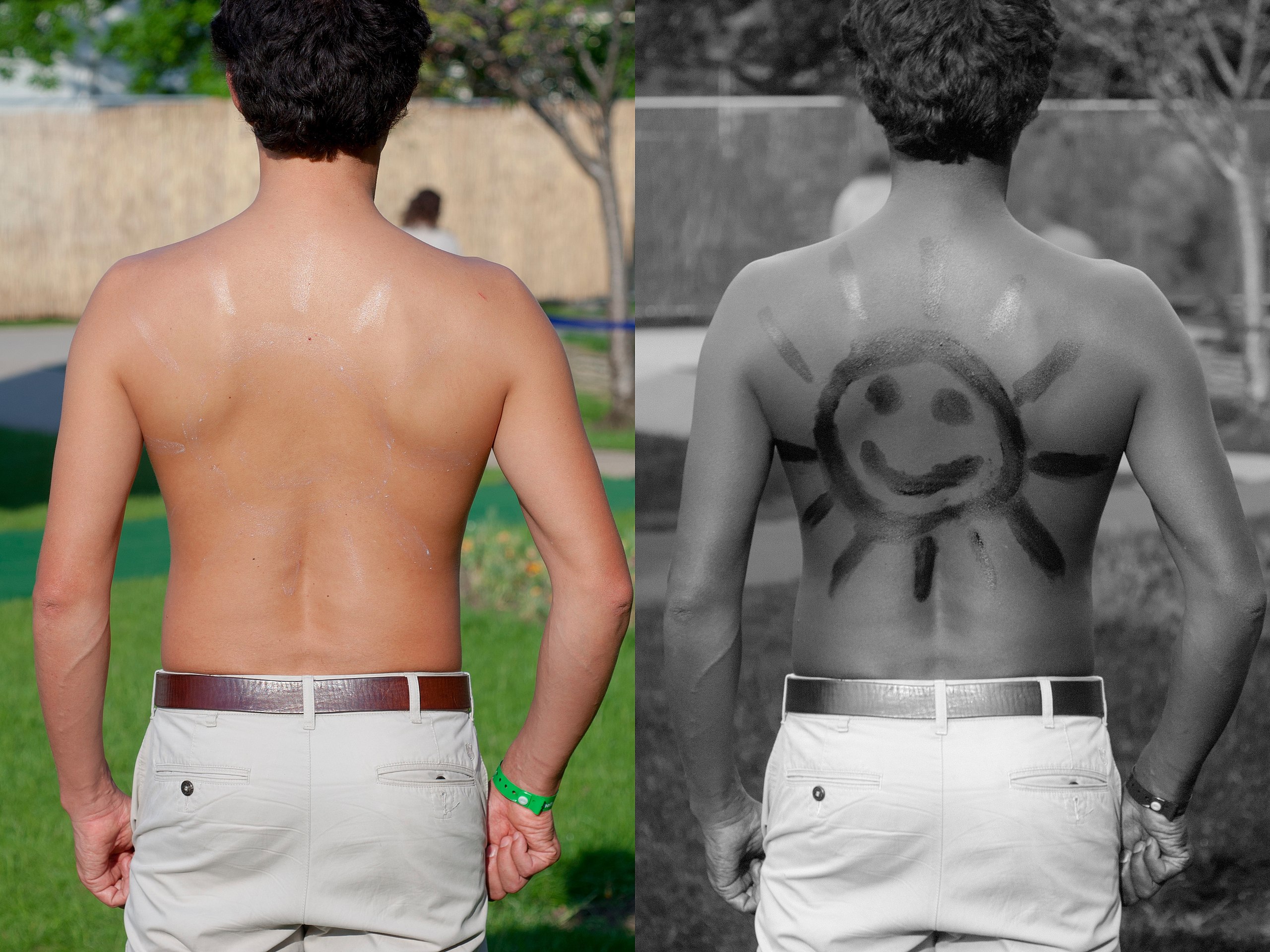
Credit: Andrew Steele, jointly released into the public domain by the person in the photo (Wikipedia user HYangWong), CC0, via Wikimedia Commons
Background
Synopsis: The potential harmful effects of sunscreen on both people and the environment have been studied over the past few years. While research is not definitive, sunscreen chemicals may in fact be harmful to humans, and at high concentrations in seawater, could damage corals, anemones, and other aquatic life. Many other human activities also damage corals and their ecosystems.
- The Sun emits three primary types of ultraviolet radiation, UVA, UVB, and UVC, with UVA having the longest wavelength and UVC the shortest.
- Earth’s stratospheric ozone layer blocks the UVC radiation (ED 391 – Healing the Ozone Layer). UVB can penetrate the top layer of the skin, causing sunburns, skin cancer and skin aging. UVA penetrates deeper into the dermis layer, causing skin aging, eye damage, and can lower the body’s ability to fight off illness.
- Modern sunscreen was developed to protect humans from UV radiation and has been in use since the 1950s, with more varieties introduced in the 1980s.
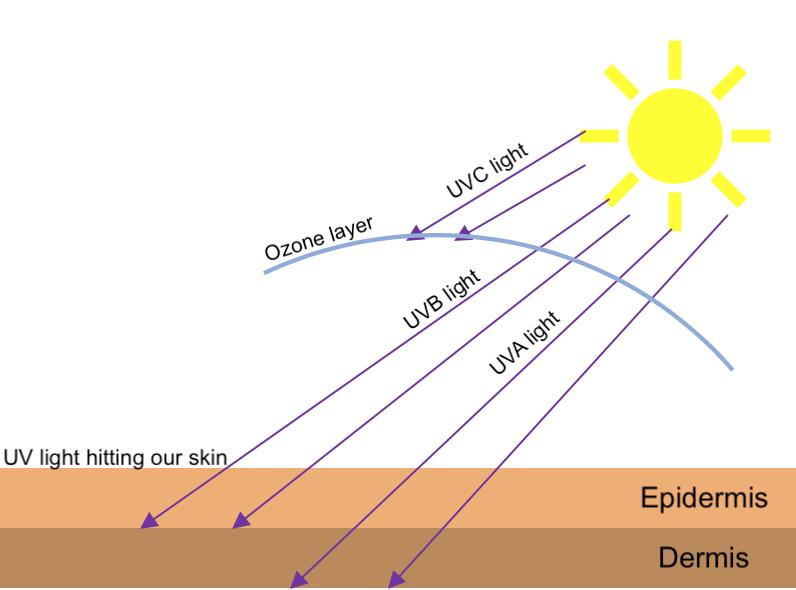
How sunlight passes through the ozone layer to damage our skin.
Credit: Ball State University, Our Dangerous Sun- There are two types of UV filters used in sunscreen. Inorganic filters include mineral compounds such as titanium dioxide or zinc oxide. These work by physically blocking and reflecting the UVA and UVB radiation.
- Organic filters include carbon-based chemical compounds such as oxybenzone, octinoxate, or avobenzone. These work by chemically absorbing the UVA and UVB energy and converting it into heat energy.
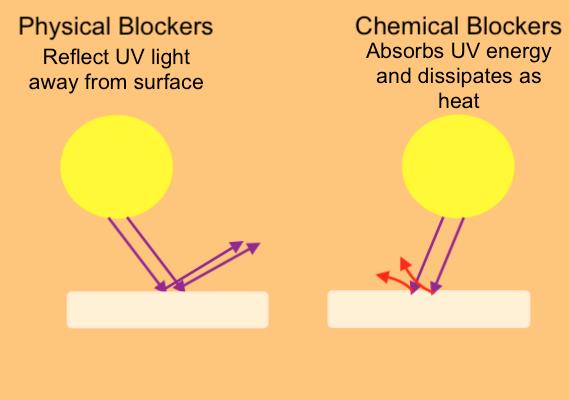
Physical and chemical sunscreens use different mechanisms to protect skin.
Credit: Ball State University, Our Dangerous Sun - The only two filters fully vetted by the FDA for sunscreen are titanium dioxide and zinc oxide which are both physical, inorganic filters.
- Many of the chemicals used in sunscreens can cause allergic reactions on the skin. Some sunscreen chemicals can even sink into the skin and be found in the bloodstream weeks after initial application.
- Some research suggests certain organic sunscreens, particularly oxybenzone, are endocrine disruptors, affecting hormones. These have been measured in urine and breast milk.
- A physical blocker like titanium dioxide (TiO2) can be carcinogenic when inhaled from spray sunscreen.
- The physical barrier sunscreens that contain titanium dioxide and zinc oxide have the fewest potential adverse effects to humans.
- If the chemicals in sunscreen could damage humans, what could be their effects on coral reefs and marine life?
- In 2008, researchers began studying the effects of significant sunscreen exposure on coral and other ocean animals.
- Coral was placed in tanks in a lab and subjected to extremely high concentrations of store-bought sunscreen. All corals exhibited bleaching, increasing the risk of mortality.
- Another study showed how the organic sunscreen agent octinoxate will degrade into the chemical benzophenone when exposed to sunlight, particularly UV light. Benzophenone is a known carcinogen and disrupts normal hormone functions.
- Certain sunscreens have been found to impair the growth and photosynthesis of algae, a vital food source for many marine animals.
- Some sunscreen chemicals have been shown to affect the fertility and reproduction of certain fish species.
- Studies suggest that sunscreen could bioaccumulate in coral tissues, and at high concentrations could induce bleaching.
- In 2022, a study on oxybenzone in anemones, a cousin of corals, found that when the organisms tried to expel the chemical from their body, it turned into a toxin. The toxin builds up in the tissue of the anemone, disrupting their symbiotic zooxanthellae algae, resulting in bleaching.
- Oxybenzone has also been shown to cause deformities in coral larvae and damage their DNA.
- Some critics have objected to these findings since the concentration of sunscreen required to produce these damages was up to ten times higher than the sunscreen found in even the most heavily visited locations.
- It is challenging to fully mimic the biodiverse coral reef ecosystem in a laboratory setting and further studies are needed.
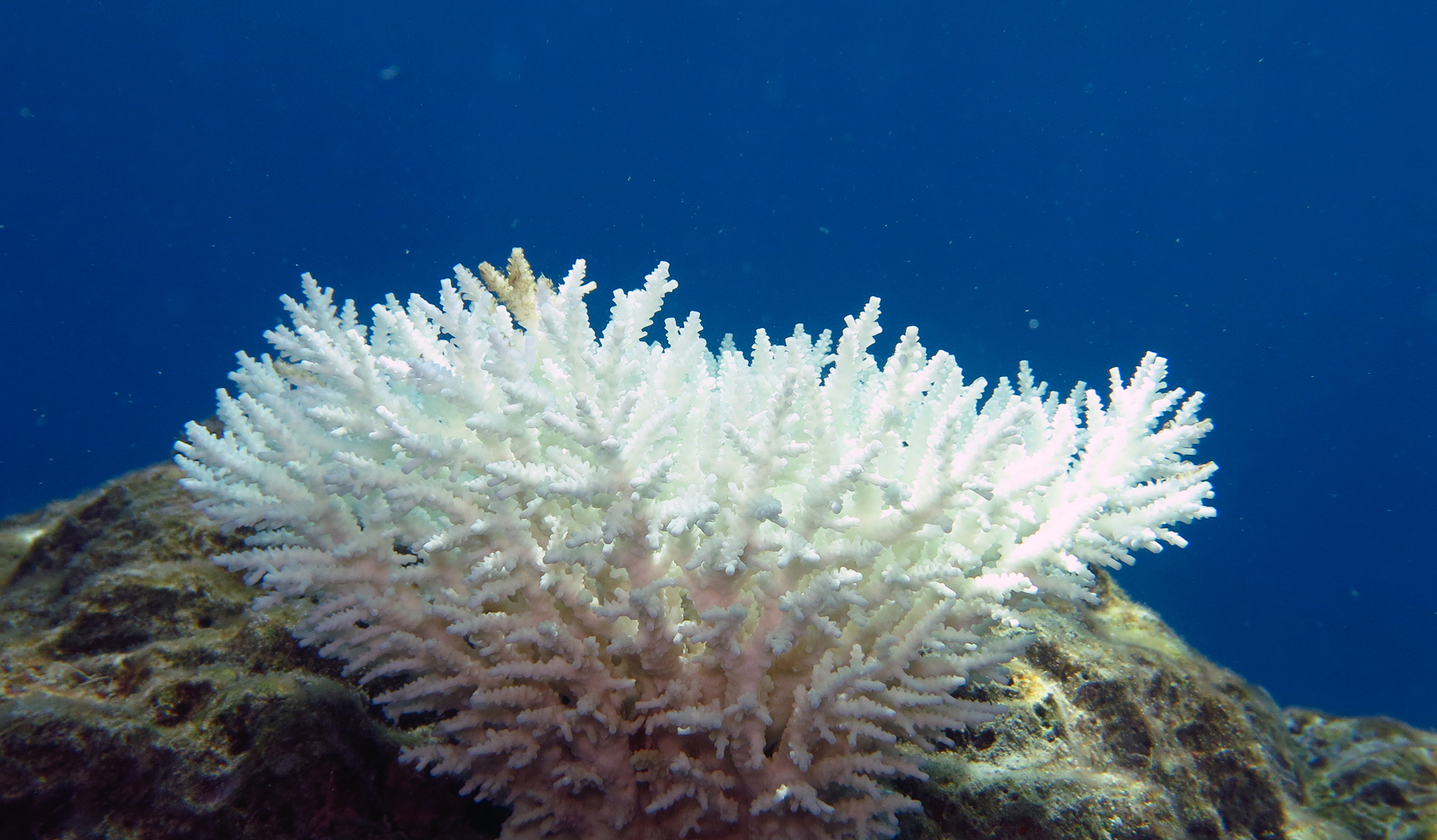
Bleached colony of Acropora coral in the Andaman Islands.
Credit: Vardhanin, CC BY-SA 4.0, via Wikimedia Commons
- Some sunscreen options may be better for the environment.
- The reef-safe or reef-friendly tags on sunscreen bottles are likely just a marketing tactic to make a brand appear eco-friendly, as there is no real regulation on what exactly “reef-safe” means.
- However, most of the sunscreens labeled as reef-safe do not contain oxybenzone or octinoxate, the two compounds suspected to be most harmful to humans and marine life. Products containing these chemicals have been banned in Hawaii and the island nations of Palau, Bonaire and Aruba.
- The safest sunscreens use mineral filters such as titanium dioxide and zinc oxide. However, they may leave a white cast on the skin and take longer to apply.
- Consumers should avoid both spray and powder sunscreens, as they easily spread through the air into the lungs and environment.
- In addition to the potential negative impact of sunscreen, many other human activities also damage coral.
- Insecticide runoff into the ocean causes harm to coral polyps, while other pollutants like fertilizer can cause algae overgrowth, suffocating coral.
- Blast fishing uses dynamite to scare fish away from their hiding places but damages coral and kills other species indiscriminately.
- Cyanide fishing involves spraying or sprinkling cyanide into the water to stun fish for live capture but damages and kills coral polyps.
- Trawling, where a net is dragged along the seafloor to catch fish, can ensnare coral and rip it away from its base, killing the entire coral head.
- In an earlier episode on coral bleaching, (ED219 – Coral Bleaching) we explain that when coral is exposed to high temperature, excessive ultraviolet light, or unfavorable water chemistry, it can expel the algae that conducts photosynthesis to feed the coral. This is the same algae, zooxanthellae that is symbiotic with anemone mentioned earlier.
- Corals are incredibly important to the environment and need to be protected along with the environments around them.
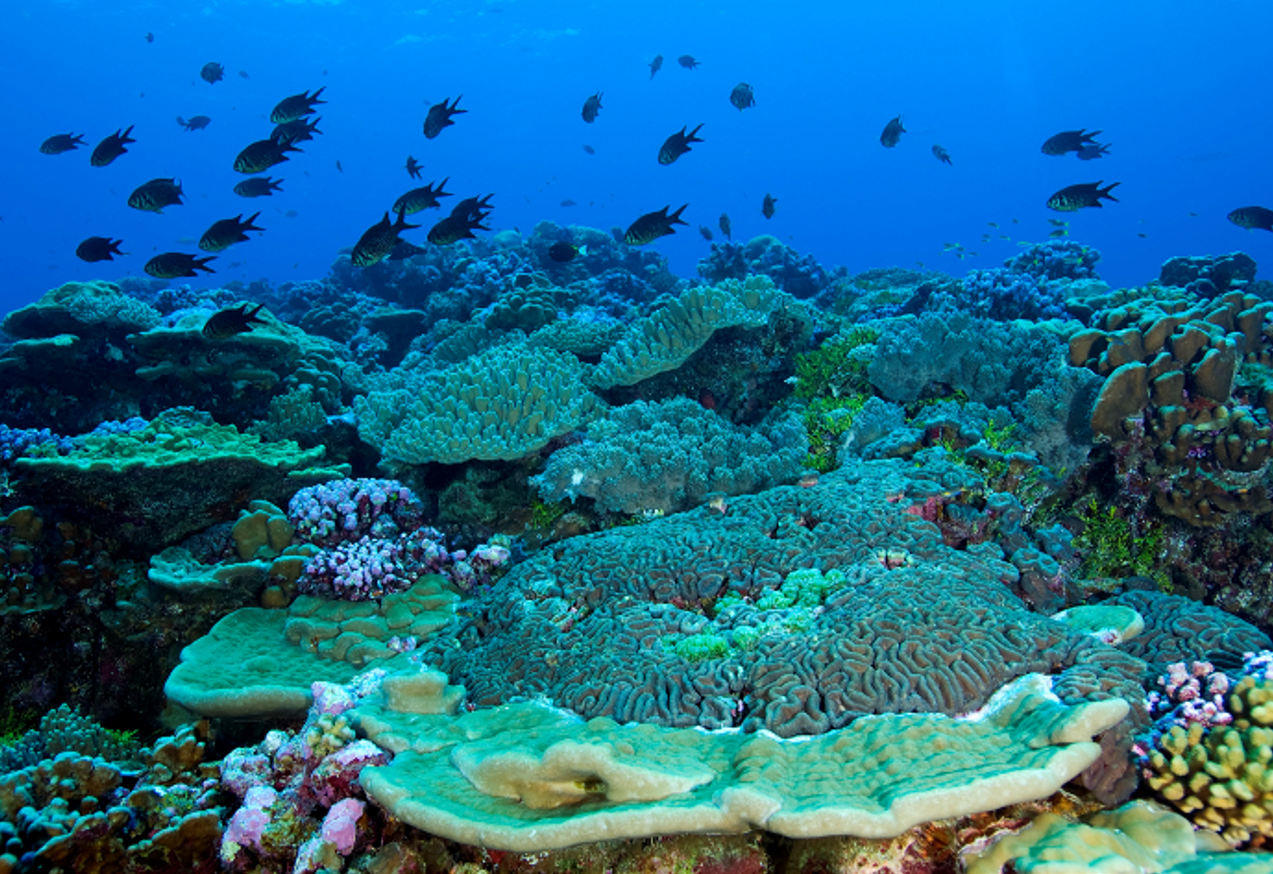
A healthy coral reef habitat on the remote Pacific atoll of Palmyra, halfway between Hawaii and American Samoa in the Pacific Remote Islands Marine National Monument.
Credit: Franklin Viola/Williams et al. (2013), CC BY 3.0, via PeerJ Life & Environment- Coral reefs are pinnacles of ocean diversity, with certain reef systems housing more than 7,000 species of marine life.
- Twenty five percent of fish rely on coral reefs, as they provide shelter and a place to breed and rear young.
- Reefs are valuable tourist attractions for scuba diving and snorkeling, bringing money into local businesses.
- These habitats also are a source of food for coastal communities and are culturally important to indigenous people around the globe.
Episode Script
You may have seen sunscreens that claim to be “reef safe.” Which may have made you wonder, are sunscreens dangerous to coral? If so, could they be dangerous to me?
Sunscreens come in two basic types. Inorganic, which are mineral based, using white zinc or titanium oxides to physically block the sun’s rays. And organic, using oxybenzone or octinoxate to absorb UV rays and turn them into heat.
You’d think the organic ones would be healthier for humans. But some studies found they can penetrate the skin, enter the bloodstream, and may interfere with endocrine systems.
In corals too, some studies showed that very high concentrations of oxybenzone sunscreen make them eject the symbiotic algae that lives within them. Without the algae to conduct photosynthesis, the corals bleach and may die.
While you should always protect yourself from the sun, you may want to avoid sunscreens with oxybenzone or octinoxate. And avoid spray or powder sunscreens as they can be toxic when inhaled.
The lowest risk, and most effective sunblock, is to cover up or get out of the sun mid-day. And use mineral-based sunscreens when needed.
If you want to protect corals, ironically one of the best things you can do may be to visit and admire—though never touch—them.
Your tourist dollars encourage local authorities to protect their reefs from fishing and overuse, and preserve them for future generations—of visitors, and coral.

